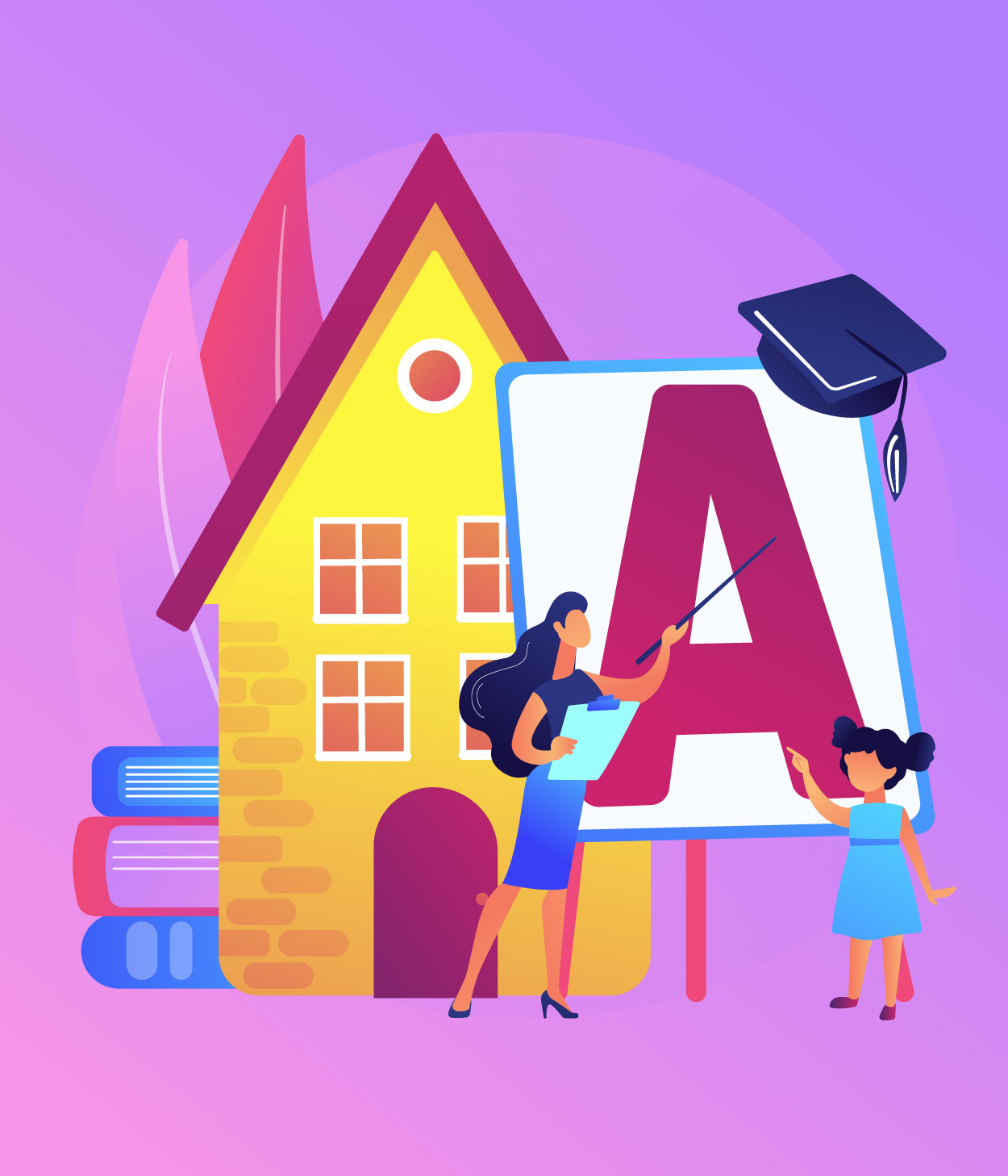Introduction: Every Day’s A School Day
Times are certainly changing! Gone are the days of spending hours perusing through a textbook to find the answers to your homework questions – everything can be found online.
This also means that the way our children learn has changed.
As time goes on and the world continues to alter, the prospect of homeschooling is beginning to become more and more attractive to parents.
Parents may choose to homeschool their children for a wide range of reasons, and it can be quite an effective method of educating our future world leaders.
So, with that being said, here’s everything that you need to know about homeschooling your children.
What Is Homeschooling?
View in gallery
To put it simply, homeschooling is essentially when children are educated from home, either by parents or by teachers that can tutor your children from home.
For many parents, it can be an attractive alternative to enrolling their children into a private or public school.
Unlike in a traditional schooling system in an educational institution, there is no specific formula for teaching from home.
The school curriculum that you teach will depend on the preferences of you and your child, providing you with endless possibilities and flexibility.
Of course, if you would prefer to make your homeschooling replicate what you would normally learn in a classroom, then this is certainly an option – but it doesn’t hurt to deviate from the norm if you wish!
It’s possible for any child to be homeschooled, so long as they are going to be given a full time education.
Parents, guardians or tutors can all teach your children on a daily basis. You don’t necessarily need to be a qualified teacher to educate your child from home.
If you have a child that’s currently enrolled in a Special Educational Needs (SEN) school, then you will first need to get the permission of the school before you take them out of school to begin homeschooling them.
Here’s more about homeschooling a child with special education needs.
A Rise in Popularity: Home Schooling After Covid-19
View in gallery
Homeschooling was already becoming a popular option for many parents, but after the Covid 19 pandemic, more and more children are being homeschooled.
The world can be a scary place for a child in the middle of a pandemic, so many children are instead opting to help their children to hit the books from the comfort of their own homes.
Not only this, but many parents have feared for the safety and their loved ones, and have chosen to pull their children out of school to avoid their child potentially coming into contact with the virus.
For many children, being educated at home with their parents makes them feel safe in an otherwise uncertain world. It can help them to learn without the distractions of what’s going on around them.
Many parents also began to work from home as a result of the Covid 19 pandemic, so homeschooling became an additional way to bond with their children and to take a more active role in their education.
Many parents also feel that homeschooling is an attractive alternative to the unknown of virtual learning with an educational institution.
The State of Homeschooling Pre-2020
View in gallery Homeschooling didn’t only start to become popular in 2020, however.
Homeschooling didn’t only start to become popular in 2020, however.
For many years, parents across the globe have taken to this way of schooling for a wide range of different reasons.
These are just a few of the things that you need to know:
- The practice of homeschooling has been legalized in the United States since the 1990s, and the percentage of homeschooled students has only risen through the past 20 years. By Spring 2019, it was estimated that around 2.5 million children were homeschooled. The number of students homeschooled varied by state, with states such as North Caroline, California, and Texas being the most popular states for homeschooling.
- According to the study, between the years 2011-12, the most common demographics for homeschooling included White children (83 percent), Hispanic children (7 Percent, Black children (5 percent), and Asian or Pacific Islanders (2 percent).
- Many different homeschooling resources were available to children being homeschooled even before 2020, including co-ops, online resources, district extracurricular participation, homeschool assistance programs, and micro-schools. Winzo
Homeschooling Stats During Covid 19
View in gallery The number of households homeschooling has certainly increased through the years, but during 2020 this practice has seen a big boom.
The number of households homeschooling has certainly increased through the years, but during 2020 this practice has seen a big boom.
According to the National Home Education Research Institute, more and more parents are becoming aware of home schooling and more people have become interested in the idea.
There are several reasons for this. To start with, many parents fear for the safety of their children.
The more people their children are around, the more likely their children are to contract the Covid 19 virus. By keeping children at home, the exposure is significantly limited, thus keeping the whole family safe.
Not only that but the Covid 19 pandemic has certainly highlighted one thing to many parents – you don’t have to be in a school to learn.
There are a range of different homeschooling resources out there, in addition to support groups and curriculums to make the transition that much easier for parents and children.
According to the research conducted in a RealClear Opinion Survey, 40% of families are more likely to begin homeschooling or participating in virtual schools after the lockdowns have finished.
The highest demographic of parents to answer ‘most likely’ in this survey was the age range of 18-34. More black and Asian parents were said to be likely to homeschool their children following lockdowns.
According to the 2020 Schooling in America survey, 28% of parents said that they removed their children from the traditional school system to keep their children safe.
In addition to this, in the same survey, near a fourth of parents surveyed said that they are likely to homeschool in the following academic year if they aren’t already doing it.
Many parents are doubtful over the effectiveness of educating children virtually, such as methods such as video calling.
Instead, parents are choosing to take the reins into their own hands and educate their children by themselves.
So to summarize, these are the key takeaways:
- Most parents have chosen to remove their children from school during the Covid-19 pandemic due to safety concerns
- Parents have started to doubt the effectiveness of virtual teaching amidst the pandemic, and so they have taken to homeschooling.
- More people are likely to homeschool following the Covid-19 pandemic, according to the Schooling in America survey. The concept of homeschooling is rising in popularity.
Why are More Parents Considering Homeschooling?
Aside from the Covid 19 Pandemic, there are many reasons why parents are opting to homeschool their children.
View in gallery One reason is that when you are homeschooling, you have more quality time with your children.
One reason is that when you are homeschooling, you have more quality time with your children.
It can become incredibly easy to get sidetracked by the busy-ness of life, but when you’re homeschooling you’re spending quality time with your children while they get an education.
It’s also a bonding experience that they’re likely to remember for the rest of their lives.
You can even educate flexibly to fit with the schedules of the whole family.
Homeschooled children also get extra time with their teachers. This means that there’s more availability to ask questions, and for you to work directly with your child to make sure that they’re understanding the subject material.
Suggested Article: 394 Questions To Ask Kids
This means that children can learn at a pace that works for them, and children get one on one teaching that can be catered to their unique learning needs. This often translates to homeschooled children performing better in tests.
On the subject of a child’s learning needs, every child learns differently. All children that are homeschooled can have an education tailored to their personality and abilities.
For instance, if a child is incredibly good at a certain subject then it means that a teacher can really hone in on their abilities in that area.
On the other hand, if a child is struggling in a certain subject then it means that additional resources can be acquired to help them with their learning.
Different learning styles can be accommodated for. This isn’t as much of an option in a public or private school as teachers have to cater to an entire class instead of just one student.
One big concern when it comes to homeschooling children is that children aren’t around their peers all the time, so many parents worry that it means their children’s’ social skills could be stunted.
The good news is that this certainly isn’t the case.
Children don’t have to be home all the time – they can be educated in areas where there are other children around, and they can also participate in extracurricular activities where there will be other children.
Homeschooling is fantastic for children that struggle with their mental health in a lot of circumstances.
If you homeschool your child, it means that parents can prioritize things such as coping skills, medical care, and therapeutic practices throughout the day.
It allows the child to be surrounded by loved ones which can help a child’s emotional wellbeing.
For many parents, one big problem with learning in a public or private school setting is that children simply have to learn the syllabus to a test, rather than learning a whole breadth of knowledge that will last for their entire lives.
While this may not be true for every school, it can be argued that this is certainly correct for many. If you homeschool your child, you get to choose to an extent what they learn about.
This can help to give them a wider variety of knowledge in many respects, and you can even cater to the learning experience to the child’s interest. You may even find that you learn some new things, too!
On that note though, it does mean that you can also work on key life skills that may not be taught in a standard school environment.
You can prepare your children for adult life by taking the time to teach them about things like how to cook, or how to budget. This can help them to grow into well-adjusted adults who are clued up on the key skills needed as an adult.
Some other common reasons that parents cite for choosing to homeschool their children include having visibility of the school curriculum.
For example, if you are homeschooling, then it’s a good way for people of faith to teach their children their religion in depth.
It can also help if a child is being bullied as it removes them from an environment that it can be difficult for them to learn it.
Students with behavioral problems and special needs students can also benefit from homeschooling. Some families may also choose to homeschool as it allows them to travel rather than be rooted to one single location.
Your Guide to Setting Up a Successful Homeschooling Environment
View in gallery
When it comes to educating a child, it isn’t practical to approach it without a plan.
While one of the key benefits of homeschooling is the flexibility that it offers, having a routine and a structure of some kind in place can be incredibly helpful to ensure that the endeavor is a successful one.
Of course, it’s only natural to consider that each family is unique. What may work for one family may not work for another family, so you need to do what’s best for you.
With that being said, here are just a few of the things that you should consider and plan for when it comes to beginning to homeschool your children.
1. Familiarize Yourself with Your State’s Requirements
View in gallery The very first thing you need to do when you are considering homeschooling your children is to consider the homeschool laws in your state, and the requirements.
The very first thing you need to do when you are considering homeschooling your children is to consider the homeschool laws in your state, and the requirements.
You can find your state’s homeschool laws here.
There’s no one single rule for homeschooling that covers the entire United States – instead, it covers specific states.
Certain states may have certain legal parameters that must be met for you to homeschool your child.
For instance, some states will classify a homeschool as a private school, and this means that they are treated similarly. Other states may not have any regulations on homeschooling.
If you’re confused about the regulations, don’t panic. While it may seem difficult to follow the regulations if there is a lot of legal jargon involved, you can ask for help with state and local homeschool groups.
Ultimately though, you should be checking with the state code which you can normally find on the internet by checking the official website of your state.
2. Explore Homeschooling Methods
View in gallery The world is your oyster when it comes to homeschooling, but there are a few key methods to take into account.
The world is your oyster when it comes to homeschooling, but there are a few key methods to take into account.
The key methods are Classical, Charlotte Mason, Unschooling, Montessori, School at Home, Unit Studies and Eclectic Education Methods.
Here’s a quick summary of each style. Read on for more in depth information:
| Teaching Method | Pros | Cons |
| Classical Homeschooling |
|
|
| Charlotte Mason Method |
|
|
| Montessori |
|
|
| Unschooling |
|
|
| School-At-Home |
|
|
| Unit Studies |
|
|
| Eclectic |
|
|
Classical Homeschooling
The first style is the classical homeschooling method, which is the most commonly used style among homeschooling parents.
You can read more about this particular medium of teaching here. This method of homeschooling has been used for thousands of years, so it’s been proven to work.
With this mode of homeschooling, children are introduced to highly important ideas that have been devices throughout history across the road, and it introduces children to key literature.
Children learn a range of languages, from Biblical Hebrew to Latin and Greek, among European languages. It’s ideal for most kinds of students, including those with dyslexia.
As children progress through their schooling, they’re taught skills like speeches, debates, essay writing, independent thinking, economics and communication.
Of course, there are also some downsides to this homeschooling method too. First of all, your children will need to do a lot of memorizing, in addition to narration and dictation.
For some children, especially those that are keen on reading, it can be ideal but for some, it could be more challenging.
It requires a lot of discipline too, which can be discouraging for some, and there’s not a lot of material in the form of science learning with this approach.
Many also find that it can be an inflexible way of learning, and that learning things like Greek and Latin aren’t particularly practical for the modern student.
In short, it’s a great choice for parents and learners that want to introduce their children to influential books, who would rather stick to the traditional modes of learning from the home.
It’s ideal for parents that want their children to learn foreign languages, and it’s a good choice if you wish to introduce your children to abstract thinking. Above all else, it’s a method that has been proven to work, which is a pretty big selling point.
Charlotte Mason Method
The Charlotte Mason Method of homeschooling prioritizes educating children with living books, good habits, and experiences.
The distinguishing feature of this methodology is the ‘living books’ part, which essentially means that the books are written by those who have passion for what they have written.
The books are normally written in a more laid-back manner that draws children in to the subject material.
This is the ideal method of homeschooling if you want to prioritize the arts in your teaching.
Creativity is a highly sought after thing in adult life, and the Charlotte Mason Method certainly caters to this essential life skill. This method has been around for more than 100 years, so it’s certainly reliable.
This method often incorporates things like journaling for assessment rather than regimented tests. You can also have your children take nature walks as part of this method of teaching. This is great for teaching them science and creativity skills, allowing them to learn how to be observant.
It’s a very affordable method of teaching as a whole, and it’s also a Christian mode of learning which is ideal if you wish to give your child an education where religion is a central pillar of learning.
On the other hand, this method does focus on living books, which means that you will need to acquire a lot of books to teach.
This can get rather expensive after a while, as you will need to keep purchasing the books as time goes on and your child’s education progresses.
It also isn’t particularly strong when it comes to teaching mathematics, and many parents/students may find this method somewhat outdated.
Montessori
This method of homeschooling isn’t one that’s commonly used by parents today, and it’s certainly a somewhat bizarre methodology. This does not, of course, make it ineffective.
The main idea behind homeschooling with the Montessori method is that children learn in stimulating environments.
It’s a very tactile homeschooling method, with things like furniture, toys, and constructs used to teach younger learners.Thanks to this, it’s a fantastic choice not only for elementary aged children, but also for special needs children.
In addition to this, the Montessori method is a great choice for encouraging creativity in children, and it’s certainly a choice for the more tactile learner.
The biggest issue with the Montessori method though is that you will need to take training to do it. This method requires certification to teach.
With that being said, you can teach in the style without using the Montessori label, but in order to ensure you’re doing it correctly it really is best to take the qualification.
It’s also more suited to elementary aged children, so it may not be the best choice for many older learners. It doesn’t have a great deal of structure either.
Unschooling
Unschooling is another unique choice worth considering. With this homeschooling method, you don’t practice traditional teaching methods, and you instead teach through everyday experiences.
In this teaching style, the parent is essentially more of a facilitator to the learning, while the child leads the way through the experience.
With this medium of teaching, children get a lot of experience in the real world, and this often results in a more hands-on learning experience.
It’s also an incredibly flexible mode of learning. Children can learn in pretty much whatever location they want at whatever time suits the parents and child.
This schooling method allows children to explore the subjects and activities that really interest them, so schooling can really be catered to the child.
On the other hand, this method has some obvious drawbacks. For starters, it’s an unstructured approach, which may not suit all children and parents.
If children are put back into a traditional school setting, then the child may have a hard time adapting to it. As it’s mostly a spontaneous mode of teaching, children may end up lacking in knowledge in certain core competencies.
School at Home
If the Unschooling method isn’t for you and you want an approach closer to ‘traditional’ homeschooling, then the School at Home methodology may be a good choice for you.
It’s essentially what would be taught in a traditional school setting, but taught at home.
This is a great mode of schooling if you would rather stick with the basics. It’s good if you may wish to send your child back to traditional school later down the line. It’s also ideal if you only plan on homeschooling for a short amount of time.
Unfortunately, School at Home teaching methods can cost quite a bit of money – in fact, while there are some more affordable options, you could be spending as much as you would with a private school.
It also means that your child is essentially forced to do a certain exercise, subject area or lesson which may not be ideal for every learner.
Not to mention, this mode of teaching can take up a lot of time.
Otherwise, it’s a tried and trusted method that could work for many parent-student combinations.
Unit Studies
Unit Studies is an incredibly versatile way of teaching, allowing for a lot of crossover in different subject areas that can be quite engaging for many students.
This can be an enjoyable mode of teaching, that can also be student-directed which is ideal for giving your child extra responsibility for their own education. It is very effective when paired with other teaching methods mentioned above.
This teaching method is quite well known for giving students gaps in knowledge, however. It can mean that certain subjects aren’t covered as extensively as they should be.
It’s also considered a rather incomplete teaching style as it’s not exactly clear what kinds of core competencies are covered. It’s also somewhat dependent on other modes of teaching ideologies.
Eclectic Education
This is another one of the most popular methods of homeschooling children. It’s commonly regarded as a relaxed form of homeschooling, and it’s pretty flexible.
It allows you to use a combination of different teaching methods that will suit what you are teaching at the time. It also means that you can cater to your child’s needs as much as possible.
This style also has the most available resources, and there are more support networks available for parents and students.
It can be a little overwhelming to have so many teaching methods at your disposal however.
It can also be ineffective to mix certain teaching methods, so you need to look into each style before you try. It’s ideal if you do prefer a more flexible approach to teaching, however.
3. Obtain Relevant Learning Resources
View in gallery Once you have completed the first two steps, it’s time to obtain your homeschool learning resources.
Once you have completed the first two steps, it’s time to obtain your homeschool learning resources.
It’s really not worth buying resources before you’ve fully decided on the learning route you are going to go down, and your child’s unique learning style, so it’s important that you assess that before you invest in a potentially expensive homeschooling program.
When it comes to buying learning resources for homeschooling, you can either purchase an entire school year’s curriculum, or you can gather a bunch of different well thought out resources and create your own curriculum, personal to your child.
Today, many resources can be acquired online, but it’s worth consulting with your homeschool support group for more advice before diving into purchasing a homeschool curriculum.
If you are looking for further information on learning resources for homeschooling, find out more here.
4. Set a Homeschooling Schedule
View in gallery One of the greatest things about homeschooling is that it’s a pretty flexible way of educating children, but it’s still good to set a schedule.
One of the greatest things about homeschooling is that it’s a pretty flexible way of educating children, but it’s still good to set a schedule.
It can be a little hard to know where to start when it comes to setting a schedule for homeschooling, but these are just a few pointers.
- Keep a Routine
This may sound like the same thing as a schedule, but honestly it’s not. A schedule usually dictates that you do a certain thing at exactly the same time each day or week.
A routine provides you with a general timeframe that you can follow. This can help your children to know what’s coming, to prepare them for the learning ahead.
This could look like a teaching block somewhere between 9-9:30 in the morning, lunch somewhere around 1-2 pm, etc.
This allows for some flexibility while still allowing both you and your child to have some normality in terms of how you organize your day.
It’s worth trying to create a plan – there are plenty of homeschool planner templates online that you can use to help you. Keep it flexible, but have a rough idea of how your week is going to look in advance.
- Keep Some Time Free
Look, we get it – Life happens! That’s precisely why we suggest not setting a rigid schedule as you would with standard schooling.
Sometimes unexpected things can happen, such as last minute illnesses, vet appointments or other emergencies. You should plan not only for the school day but also for breaks and other time off.
Also account for places where your plan may go awry. Think about things like vacations or holidays that need to be planned for, and let the schedule change if it needs to.
- Don’t Oversaturate Your Lesson Plan
The last thing you want is to overly confuse your children by trying to cram every single subject into one day. Try teaching in blocks, and stagger subjects throughout the week. Alternating days also works well.
5. Set Specific, Achievable Homeschooling Goals
View in gallery When you’re homeschooling, it’s important to set goals throughout the process.
When you’re homeschooling, it’s important to set goals throughout the process.
These goals should be ones that can be achieved and based on your child’s current and predicted progress.
First of all, you need to think about how your child is performing in certain areas right now.
Consider the progress they may have made within the last year, and what things need improvement?
Think about how you can challenge your child to achieve the goals in the long run throughout the course of the school year.
Goals should be specific, above all else. A goal like ‘Samantha will learn to count’ is not as effective as something that’s more specific, such as ‘Samantha will practice counting to ten on three days of the week for 15 minutes a day, and will focus on writing them down, eventually moving on to addition and subtraction.’
The goal should be based on something that your child can actually learn in the long run, rather than just an activity that they can complete but not truly understand.
6. Locate Local Activities
View in gallery The best way to avoid both you and your child becoming isolated while homeschooling is to participate in local activities.
The best way to avoid both you and your child becoming isolated while homeschooling is to participate in local activities.
This could be a virtual activity, or it could be something that you do in-person, such as field trips, classes, and more.
It’s a good idea to see if there are any homeschooling groups near to you.
This way, local parents can arrange trips and activities for all the children to socialize.
You can find nearby homeschooling groups and activities by searching online, but if you’re already part of a group then you can also ask your peers.
You could also go to things like book fairs and events, which can be great places to connect with other homeschooling parents.
7. Find Other Local Families Who Are Homeschooling
View in gallery Homeschooling can be a pretty daunting task if you’ve never done it before.
Homeschooling can be a pretty daunting task if you’ve never done it before.
That’s why it’s so important to engage with families nearby that are homeschooling.
Not only can this help you to feel less isolated, but if you have any struggles or need advice then it means that you can ask someone else who’s been through the same struggles as you.
Where do you even start with finding families nearby that are homeschooling? Well, you could ask at your local library – your local librarian may know of a few families nearby.
If you go to the playground with your children during the day, you could also ask the families there if they homeschool.
You could also look online on things like Facebook groups or homeschooling forums, or put out a flyer asking other homeschooling families to connect.
8. Incorporate Your Support Network
View in gallery They often say that it takes a village to raise a child.
They often say that it takes a village to raise a child.
With that statement in mind, it should come as no surprise that your friends and family can be a huge asset when it comes to homeschooling.
Your family may even have strengths in areas where you struggle, for instance, you may be a whizz at math but your skills in science aren’t quite as strong.
Your sister, on the other hand, can recite the periodic table of the elements by heart.
It can be a great way for your child to bond with other family members while they learn too, and it can allow you some time to run errands without your child in tow.
Just make sure that your family members consent to the idea before you enlist their help!
Homeschooling Resources
View in gallery
If you’re looking for ways to make your homeschooling even more fun for you and your child, why not check out these resources?
- Teaching your child to read – https://www.theclassroomkey.com/2018/02/how-to-teach-child-to-read-ultimate-guide.html
- A fun site with video learning resources – https://ed.ted.com/
- National Geographic elementary resources – https://www.natgeokids.com/uk/primary-resource/
- Math fun with linking cubes – https://www.triumphantlearning.com/math-activities-linking-cubes/
- Learning perimeter and area – https://www.triumphantlearning.com/teaching-perimeter-and-area-with-geoboards/
Summary: Back to School
Homeschooling is a fantastic alternative to traditional schooling methods for many parents. With added flexibility comes extra time with your children, and you can have an active hand in shaping their learning and development.
It’s not always easy, but for parents who are willing to put in the work, it’s a rewarding experience, especially in a world after Covid-19.
As long as you properly prepare and have all of the right resources in place, your homeschooling experience is sure to be a success. You may even learn a thing or two yourself!
References:
https://www.homeschool.com/articles/special-needs/
https://www.nheri.org/research-facts-on-homeschooling/
https://nces.ed.gov/fastfacts/display.asp?id=91
https://www.edchoice.org/research/schooling-in-america-covid-19-k-12-education/





















